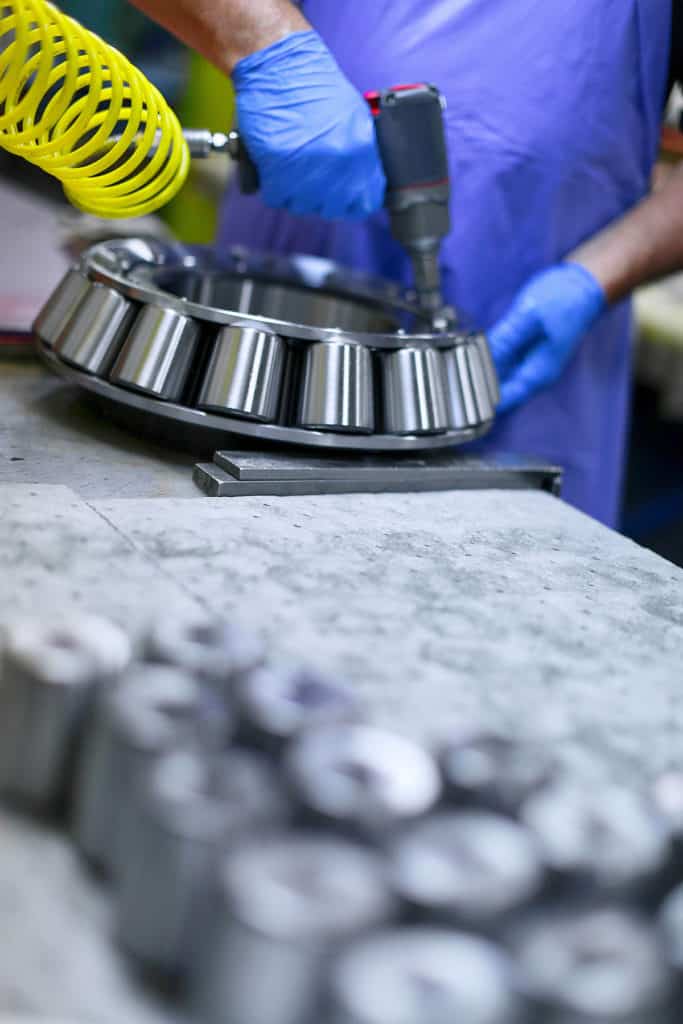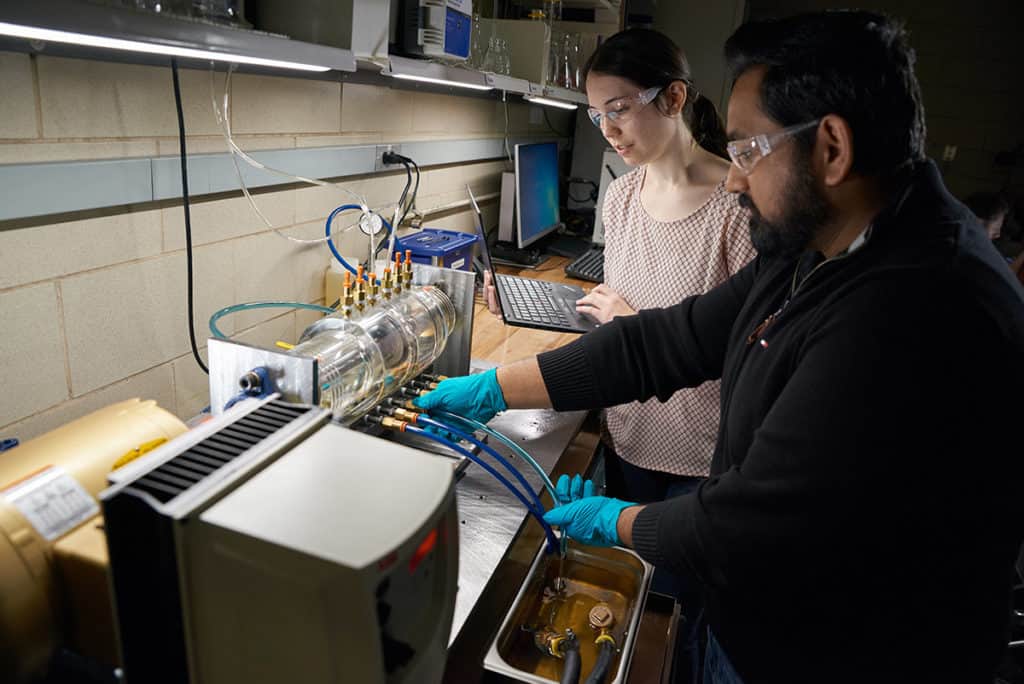Innovation
Predicting Power Train Efficiency: Timken’s Rheology Lab
A few years ago, Ryan Evans found himself sitting across from a customer with an unusual request. “He wanted to know how accurately we could predict the power loss behavior of our bearings in their application,” says Evans, who currently runs bearings research and development (R&D) for The Timken Company.
Application engineers use Timken’s® Syber® bearing performance prediction software to model different bearing selections. SYBER provides estimates for torque and power loss, but this customer seemed to be asking for another level of confidence in that prediction, as it applied to his application.
The science of bearing power loss covers a lot of ground—from fluid mechanics to solid mechanics, thermodynamics and heat transfer. “It includes the study of how properties of matter, whether they’re steel or liquid, change when subjected to the physics of high pressures, speeds and temperatures in tribological contacts,” says Bill Hannon, product fundamentals scientist at Timken.
A single tapered roller bearing, for example, might have 15 rollers encased in its rings, representing many different contact points. To calculate torque, you have to take into account how all those different contact points are likely to respond to the loads and speeds of a particular application—whether the material might flex under those points, for example, or whether the oil between them is being sheared.
“Adding all that up in a way that gives you the total power loss or torque performance for a bearing can be daunting,” says Evans.

Taking bearing efficiency beyond the bearings
Nevertheless, similar customer requests kept coming. “There’s pressure on our customers to improve fuel efficiency,” says Evans. Manufacturers in a broad range of industries—from tractors to delivery trucks to luxury cars—are responding with a move to electric vehicles. To minimize battery weight and maximize range in those vehicles, they’re under pressure to minimize friction at every point in a machine.
Bearing efficiency is one of those points, but it’s not like Timken hasn’t been designing fuel-efficient bearings for decades. The company’s power-dense, fuel-efficient bearings have played a role in conventional and hybrid vehicle design since Corporate Average Fuel Economy (CAFE) regulations began raising fuel efficiency targets in 1975.
Dave Casey, principal product development engineer at Timken, works on developing solutions that increase bearing efficiency. “At Timken, we’ve always been concerned about the friction and lost energy that goes into spinning our bearings,” he says. “To take bearing efficiency even further, we needed to understand the entire system, including what our customers were using for lubrication.”
Understanding the nature of fluids
“Customers want to run with lighter, lower viscosity fluids, and when you do that, there are hardware consequences,” says Casey. To help customers optimize bearing-lubricant combinations for ultimate efficiency, the Timken team needed to marry bearing technology with the study of rheology, the branch of physics that deals with how liquids flow.
“When I pick up some oil and hold it in my hand, I can slide it between my fingers. It’s soft and graceful,” says Hannon. “But inside a bearing, that’s not what happens. When the rolling elements meet the raceway, the contact pressure is huge, and the oil film is thin, the oil becomes almost solid.”
In other words, the oil viscosity or resistance to flow can change in strange ways as the application pressure, temperature and shear rate in the contact points increases to extreme levels. To complicate matters, oil chemistry has changed dramatically in the past decade. “There used to be a handful of viscosity modifiers, and now there are hundreds,” says Hannon.
Predicting bearing efficiency involves understanding the nature of the exact liquid, oil, or grease in each application. In an ideal world, says Hannon, application engineers would be able to measure lubricant behavior at three gigapascals, or 435,000 pounds per square inch.
“No one can do that,” he says. “Very few laboratories in the world can measure above one gigapascal.”
In addition, he says, engineers need to understand how oil viscosity changes with application pressure, temperature, and shear. “We know of only three places in the world can do that,” says Hannon: Georgia Institute of Technology (Georgia Tech), Institut National des Sciences Appliquées (INSA) in Lyon, France—and now, Timken.
A lab where scientists can see into grease
Timken’s rheology lab started with a theory, says Hannon, that the company could use the principles of physics to improve its torque prediction model. To test that theory, the team asked researchers at Georgia Tech to measure viscosity for two oils. Timken researchers then plugged those measurements into their models and found they could indeed make much more accurate bearing efficiency predictions.

“That’s when we decided to invest,” says Hannon. Today, Timken’s rheology lab houses two falling body viscometers, which measure viscosity and density at various pressures and temperatures. A Couette viscometer allows the team to measure lubricant responses to high shear rates, as well.
The lab also boasts a Fourier transform infrared spectrometer, which helps the team identify unknown fluids; an energy-dispersive X-ray spectrometer, which tells them what wear components might be in the fluid; a Karl Fischer titration unit, which can detect water in oil; and a few other “devices that allow us to beat up grease,” according to Hannon.
Letting theory drive the models
Using that equipment, Hannon and Casey can measure individual fluids and use the data to build new mathematical models that allow them to predict an infinite range of conditions within a multidimensional space.
“We’ve taken it back to the principles of fluid mechanics, so that theory drives our models,” says Hannon. Studying things on a first-principle level allows the team to predict friction, rather than just measuring it. At the same time, he says, “the rheology lab takes us one step closer to reality, reducing the number of assumptions so that we get closer to mimicking the actual application conditions.”
“These new measurement techniques allow us to measure oils in ways we’ve never been able to before,” says Evans. “We plug those data into mathematical models that help us predict how a fluid will behave under the high-pressure and -shear conditions in a bearing. That information allows us to sharpen our predictions of overall torque or power loss performance.”
From the lab to the customer design table
As the R&D team adds the new mathematical models to Timken’s® Syber® system, application engineers around the world gain access to more accurate power loss estimates. “SYBER helps us get information and knowledge out of the lab and into the hands of our customers,” says Evans.
Hannon and Casey stay in close contact with lubricant manufacturers, who are increasingly opening the door to a wider array of fluids. “The future of this is being able to pair your lubricant with your bearing,” says Hannon. “In the rheology lab, we can confirm that fit, so now we’re all working together as one team: the lubricant manufacturer, the bearing manufacturer, and the customer.”
Casey points out that the benefits of the rheology lab extend to Timken’s entire line of power transmission products. “It opens up our ability to help customers with entire systems, not just their bearing solutions.”
Hannon agrees. “Ten years ago, customers would buy a bearing,” he says. “Today, they want to buy a system. They want to know, ‘How does your bearing work with this lubricant, this seal, this gear?’” With new models and data from the rheology lab, engineers can understand better how everything works together and share that with customers.
Customers appreciate the opportunity to further optimize their designs. “With these approaches, we can predict bearing performance with more confidence than ever before,” says Evans. “Almost all of Timken’s engineered bearings and mechanical power transmission products rely on lubrication to perform well. Nearly everything we do here benefits from this work.”
Last Updated: 2025/07/17
Published: 2019/09/13
